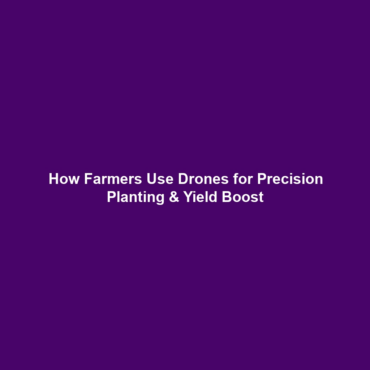Examples of Farmers Using Drones for Precision Planting and Yield Optimization
Introduction
In recent years, the integration of drones in agriculture has revolutionized traditional farming practices, enabling farmers to leverage technology for enhanced efficiency and productivity. The use of drones for precision planting and yield optimization is a prime example of how drones in science are reshaping agricultural methodologies. By employing drone technology, farmers can analyze soil conditions, monitor crop health, and apply inputs more accurately and effectively, significantly impacting yield outcomes.
Key Concepts
Understanding the vital concepts within the realm of drones in science can provide deeper insights into their application in agriculture. Here are some key principles:
- Precision Agriculture: This methodology focuses on using technology to monitor field variability in crops, enabling targeted applications of water, fertilizer, and pesticides.
- Data Collection: Drones equipped with sensors and cameras capture high-resolution aerial imagery, allowing farmers to collect vital data on crop health.
- Real-time Analytics: The data gathered can be processed to inform immediate actions, improving response times to agricultural needs.
Applications and Real-World Uses
The practical applications of drones for precision planting and yield optimization are numerous and growing, demonstrating their value in drones in science. Here are some significant examples:
- Field Mapping: Farmers use drones to create detailed maps of their fields, identifying variations in crop health and soil properties.
- Planting: Some farmers have started utilizing drones for seed planting directly, ensuring precise placement, especially in hard-to-reach areas.
- Crop Monitoring: Drones allow for continuous monitoring of crop progress, which facilitates timely interventions when issues arise.
Current Challenges
Despite their benefits, there are challenges in applying drones for precision planting and yield optimization within the field of drones in science. Some of the key issues include:
- Regulatory Restrictions: Different regions have varying regulations regarding drone usage in agriculture.
- Initial Investment: The cost of purchasing drones and associated technology can be prohibitive for small-scale farmers.
- Data Management: The integration and analysis of the vast amounts of data gathered by drones can be complex and require specialized knowledge.
Future Research and Innovations
Looking ahead, the future of precision planting and yield optimization using drones is promising. Innovations on the horizon include:
- Artificial Intelligence (AI): The use of AI will enhance the ability to interpret drone-collected data for better decision-making.
- Autonomous Drones: Advancements in autonomous drone technology are expected to reduce labor costs and increase efficiency.
- Improved Sensors: Future drones will likely come equipped with advanced sensors, providing more detailed insights into plant health and soil conditions.
Conclusion
The integration of drones for precision planting and yield optimization is significantly transforming the agricultural landscape. As part of the broader trend of drones in science, these technologies are set to improve food production efficiency and sustainability. Continued research and investment in drone technology will pave the way for even greater advancements in the agricultural sector. For farmers interested in enhancing their practices, embracing drone technology offers considerable benefits. For more insights on the impact of drones in various fields, explore our related articles on drone applications and agricultural innovations.
